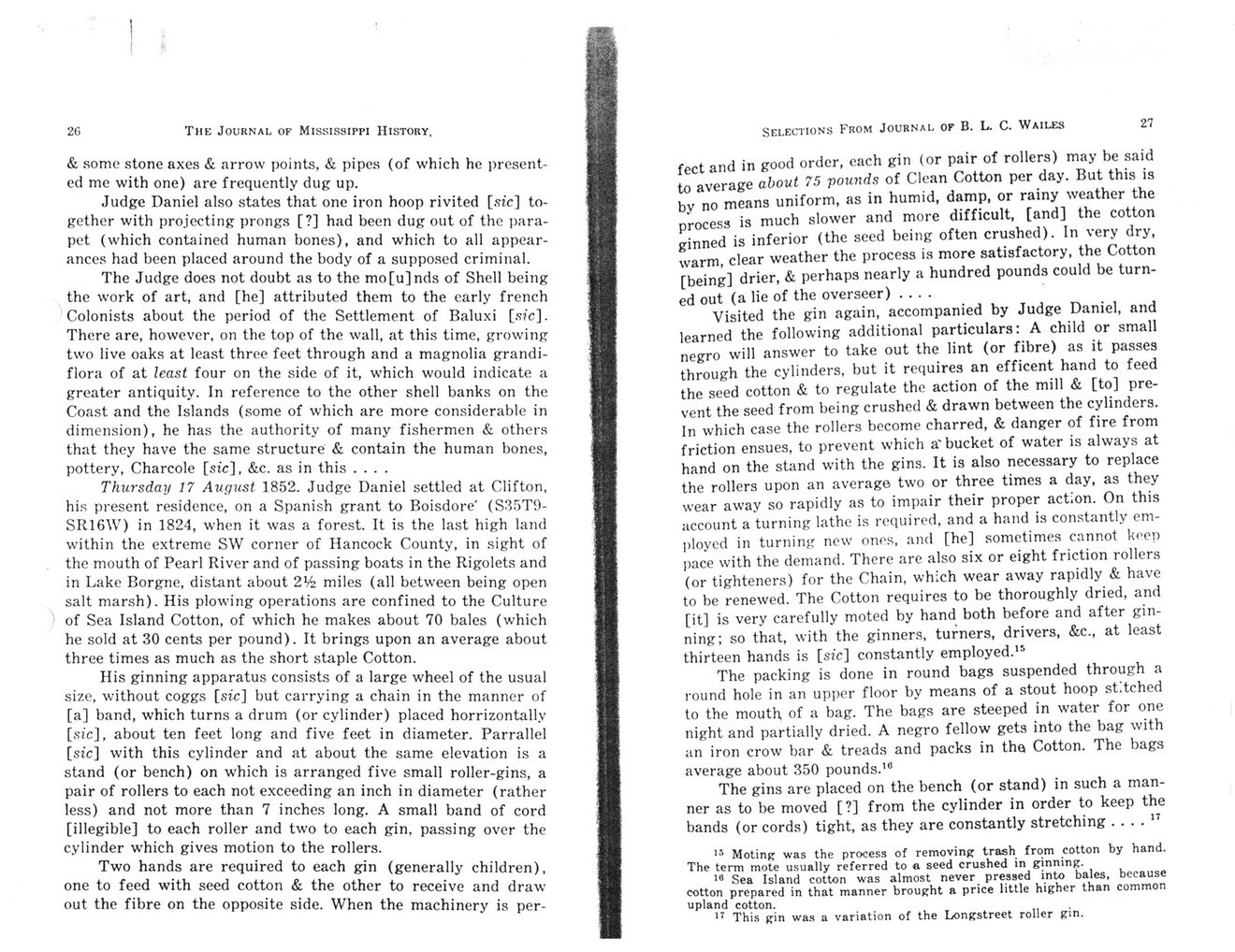This text was obtained via automated optical character recognition.
It has not been edited and may therefore contain several errors.
2G Tjie Journal of Mississippi History, & some stone axes & arrow points, & pipes (of which he presented me with one) are frequently dug up. Judge Daniel also states that one iron hoop rivited [sic] together with projecting prongs [?] had been dug out of the parapet (which contained human bones), and which to all appearances had been placed around the body of a supposed criminal. The Judge does not doubt as to the mo[u]nds of Shell being the work of art, and [he] attributed them to the early french Colonists about the period of the Settlement of Baluxi [sic]. There are, however, on the top of the wall, at this time, growing two live oaks at least three feet through and a magnolia grandi-flora of at least four on the side of it, which would indicate a greater antiquity. In reference to the other shell banks on the Coast and the Islands (some of which are more considerable in dimension), he has the authority of many fishermen & others that they have the same structure & contain the human bones, pottery, Charcole [sic], &c. as in this .... Thursday 17 August 1852. Judge Daniel settled at Clifton, his present residence, on a Spanish grant to Boisdore' (S35T0-SR16W) in 1824, when it was a forest. It is the last high land within the extreme SW corner of Hancock County, in sight of the mouth of Pearl River and of passing boats in the Rigolets and in Lake Borgne, distant about 2Vz miles (all between being open salt marsh). His plowing operations are confined to the Culture ) of Sea Island Cotton, of which he makes about 70 bales (which he sold at 30 cents per pound). It brings upon an average about three times as much as the short staple Cotton. His ginning apparatus consists of a large wheel of the usual size, without coggs [sic] but carrying a chain in the manner of [a] band, which turns a drum (or cylinder) placed horrizontally [sic], about ten feet long and five feet in diameter. Parrallel [sic] with this cylinder and at about the same elevation is a stand (or bench) on which is arranged five small roller-gins, a pair of rollers to each not exceeding an inch in diameter (rather less) and not more than 7 inches long. A small band of cord [illegible] to each roller and two to each gin, passing over the cylinder which gives motion to the rollers. Two hands are required to each gin (generally children), one to feed with seed cotton & the other to receive and draw out the fibre on the opposite side. When the machinery is per- Selections From Journal of B. L. C. Wailes 27 feet and in good order, each gin (or pair of rollers) may be said to average about 75 pounds of Clean Cotton per day. But this is by no means uniform, as in humid, damp, or rainy weather the process is much slower and more difficult, [and] the cotton ginned is inferior (the seed being often crushed). In very dry, warm, clear weather the process is more satisfactory, the Cotton [being] drier, & perhaps nearly a hundred pounds could be turned out (a lie of the overseer) .... Visited the gin again, accompanied by Judge Daniel, and learned the following additional particulars: A child or small negro will answer to take out the lint (or fibre) as it passes through the cylinders, but it requires an efficent hand to feed the seed cotton & to regulate the action of the mill & [to] prevent the seed from being crushed & drawn between the cylinders. In which case the rollers become charred, & danger of fire from friction ensues, to prevent which a'bucket of water is always at hand on the stand with the gins. It is also necessary to replace the rollers upon an average two or three times a day, as they wear away so rapidly as to impair their proper action. On this account a turning lathe is required, and a hand is constantly employed in turning new ones, and [he] sometimes cannot keep pace with the demand. There are also six or eight friction rollers (or tighteners) for the Chain, which wear away rapidly & have to be renewed. The Cotton requires to be thoroughly dried, and [it] is very carefully moted by hand both before and after ginning; so that, with the ginners, turners, drivers, &c., at least thirteen hands is [sic] constantly employed.15 The packing is done in round bags suspended through a round hole in an upper floor by means of a stout hoop stitched to the mouth of a bag. The bags are steeped in water for one night and partially dried. A negro fellow gets into the bag with an iron crow bar & treads and packs in the Cotton. The bags average about 350 pounds.10 The gins are placed on the bench (or stand) in such a manner as to be moved [?] from the cylinder in order to keep the bands (or cords) tight, as they are constantly stretching .... 17 15 Moting was the process of removing trash from cotton by hand. The term mote usually referred to a seed crushed in ginning. 10 Sea Island cotton was almost never pressed into bales, because cotton prepared in that manner brought a price little higher than common upland cotton. 1 ‘ This gin was a variation of the Longstreet roller gin.

Gainesville Benjamin-Wailes-1852-5